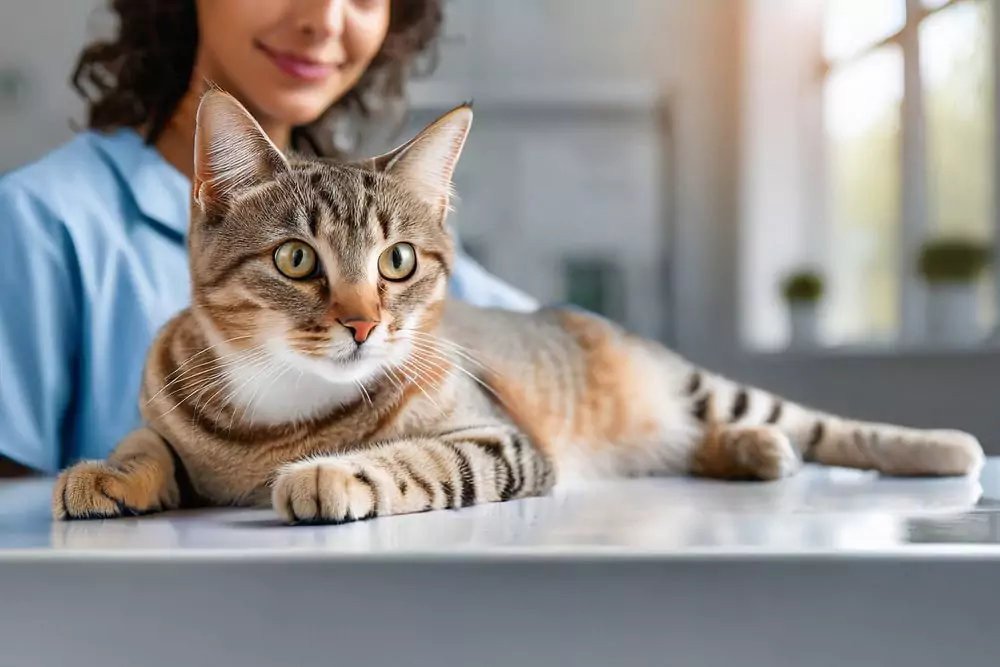PET HEALTH
No one wants their cat to get sick, but the reality is cats can face disease risks throughout their lives. One of the more concerning diseases you should keep an eye out for is feline infectious peritonitis (FIP). While FIP is a somewhat rare disease, it’s also extremely dangerous.
Keep reading to learn more about FIP in cats, what you may be able to do to help your fur baby avoid catching it, and possible treatments.
What Is FIP in Cats?
FIP is a viral disease in cats caused by certain strains of feline coronavirus (FCoV), like common, gastrointestinal-located strains of feline enteric coronavirus (FeCV).1,2,3 However, while FeCV is a coronavirus, it is an entirely different virus from SARS-CoV2, better known as COVID-19.2
If a cat develops FeCV, there’s a chance the virus could mutate into FIP. When this occurs, infected white blood cells spread throughout the cat’s body, causing major effects on various systems — like the liver, kidneys, eyes, and brain. FIP is very dangerous, progressive, and can be fatal.2,3
Still, just because your cat has FeCV doesn’t mean they’ll get FIP. While FeCV itself is a common, contagious illness among cats, only about 10% of cats with FeCV have a strain that mutates to cause FIP.3 Nevertheless, almost every cat faces the risk of a case of FeCV becoming FIP. Therefore, to understand how a cat can get FIP, pet parents need to know how cats can get FeCV in the first place.
How Do Cats Get FIP?
A cat may develop FIP weeks, months, or years after contracting FeCV. Cats usually catch FeCV after coming into contact with the feces, saliva, or respiratory particles of infected cats.3 For example, your cat might catch FeCV after using the same litter box or eating from the same bowl as an infected cat. As a result, FeCV transmission often occurs in situations where multiple cats live together, such as in shelters or multi-cat homes.3 However, even indoor cats who live alone may still face a risk of getting FeCV and FIP.
How did my indoor cat get FIP?
Although indoor cats may have less contact with other cats, that doesn’t mean they have no risk of catching FeCV or FIP. For example, taking your indoor cat to the vet or boarding them while you go on vacation are situations where they may come into contact with other cats and their germs. As a result, any pet parent should be on the lookout for signs of potential FIP in cats.
What Are the Signs of FIP in Cats?
Before your cat’s FeCV mutates into FIP, some of the signs of coronavirus infection may include mild diarrhea, upper respiratory issues, and vomiting. However, many cats get FeCV and recover from it without showing any signs. Still, once your cat’s FeCV becomes FIP, a variety of symptoms may emerge. These may include:1,2
- Diarrhea, nausea, and vomiting
- Distention of the abdomen due to fluid buildup
- Difficulty breathing
- Long fevers (lasting 2 – 5 weeks)
- Loss of appetite
- Weight loss
- Depression and sluggishness
- Problems with major systems (e.g., the kidneys, liver, spleen, pancreas and lymph nodes), including major organ failure
- Eye problems
- Nervous system problems, including seizures and uncoordinated movements
Some cats will develop what’s officially called non-effusive or “dry” FIP, while others will develop effusive “wet” FIP. As you might have guessed, a tell-tale sign of the wet form is the buildup of fluid within a cat’s body. In many cases, signs of both the wet form and the dry form of FIP may be present.1
It’s also important to remember that your cat is likely a master of hiding symptoms of illness.4 Therefore, it may be hard to notice the signs of FeCV or FIP until they’re very advanced. Moreover, some of these symptoms are signs of common illnesses in cats and may not indicate FIP. Once symptoms emerge, a vet will be able to do tests to diagnose FIP.
How Much Does It Cost To Test for FIP in Cats?
The challenge with diagnosing FIP is there’s no one, specific test that can tell you whether your cat has the condition. While there are PCR tests available, they may not precisely pinpoint whether FIP is present.5 Therefore, your vet may run a variety of diagnostic tests to make the diagnosis. The table below shows a few of the potential vet costs of such tests:
Test |
Cost |
|---|---|
$50 |
|
Blood tests |
$80 – $200 |
Fecal exam |
$25 – $40 |
$300 – $600 |
|
$150 – $250 |
Keep in mind that once your vet diagnoses FIP, there will likely be additional costs that arise. If you have pet insurance, your policy may help you with many of the costs of both diagnosis and treatment.
A MetLife Pet Policy May Help Cover FIP Costs
How Is FIP Treated in Cats?
Unfortunately, there’s no real cure for FIP in cats. Remdesivir, a drug used to treat humans infected with COVID-19, has shown some success in treating cats with FIP. However, this drug has not been approved by the Food and Drug Administration (FDA) for use by veterinarians to treat FIP.3,7 Still, your vet may be able to recommend other medications to help relieve your cat’s FIP symptoms and increase their comfort.3
How much do FIP medications cost?
Depending on what medications your vet recommends for your cat’s FIP symptoms, the costs of the prescriptions can vary. However, if you have MetLife Pet Insurance, your policy may be able to cover the costs of these prescriptions.
Has Any Cat Ever Survived FIP?
Because FIP is an incurable disease, it eventually will progress to the point of being fatal. That said, remember there may still be treatment options and care your vet can provide to help your cat continue to live with FIP. Still, don’t forget that there are ways you may be able to reduce the risk of your cat contracting FeCV and FIP.
How Can I Prevent FIP in My Cat?
While there’s no way to eliminate the risk of your cat catching FeCV that develops into FIP, there are several ways you may be able to reduce their risk. Consider these options:
- Ensure your cat receives regular veterinary care, and keep your cat’s vaccines up to date. A feline FIP vaccine is available, and while it’s a non-core feline vaccine, it may help prevent FIP in cats.1
- Clean your litter boxes, and keep them as sanitary as possible. Because FeCV is often present in fecal matter, the litter box can be a prime place to transmit the virus.
- Keep your cat’s food and water separate from the litter box.
- If you have multiple cats and one develops FeCV or FIP, it may be necessary to isolate that cat from the rest of your pet family.
All the same, it’s a good idea to prepare for the possibility of your cat developing FIP. One potential safeguard is pet insurance, and coverage may be a big help in reducing the cost for the resulting veterinary costs.
Pet Insurance May Cover Costs for Cats With FIP
The costs of diagnosing and treating a cat with FIP can easily mount. However, if you have pet insurance, your policy may cover many of these expenses, such as the costs of diagnostic tests and medications. Still, don’t wait until your cat has a diagnosis of FIP to get this coverage, as some pet insurance plans may not cover costs related to pre-existing conditions. Rather, be prepared, and get a free quote today from MetLife Pet Insurance.
We Can Help Cover Vet Bills While You Focus on Your Cat’s Care
855-270-7387


